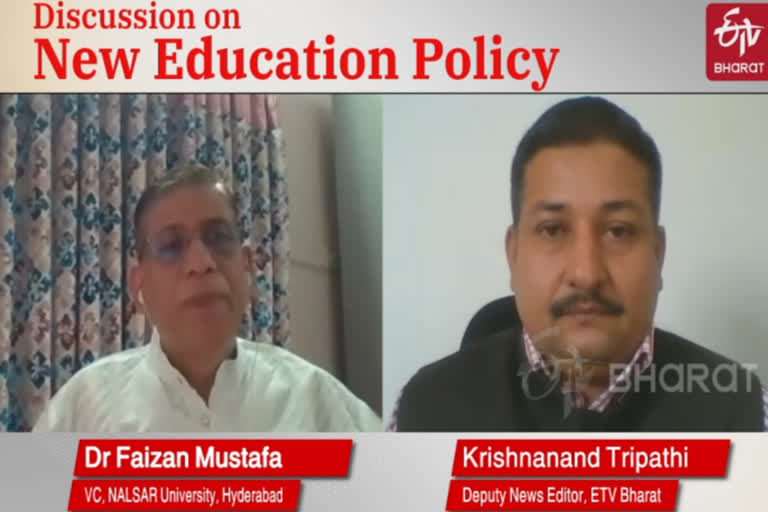New Delhi:There are several new initiatives in the New Education Policy such as its emphasis on the multi-disciplinary approach, providing multiple exit options to students at degree level and the abolition of MPhil but the policy lacks legal backing and does not deal with affirmative actions, says Dr Faizan Mustafa, Vice-Chancellor of NALSAR University in Hyderabad. In an exclusive interaction with ETV Bharat’s Krishnanand Tripathi, he said the new policy is based on the American education system but lacks similar autonomy.
Q: What is your first impression of the new education policy 2020.
A: I was Vice-Chancellor in Odisha's law university, and prior to that, I was founder-director of the law school of KIIT, a well-known institution in eastern India. It is a dated idea to look at science, art and music as distinct entities. However, even now the country is not fully prepared for integrated education for which I’ve been working for over a decade. The knowledge is there at the intersection of disciplines. I'm very happy with the integrated approach and would like to congratulate the Prime Minister for this approach but it is still a step away from the integration of knowledge.
This is the third education policy in over 70 years, which shows that the previous government did not accord enough priority to the education sector. However, this policy is not a law and it's the statement of intent by the government and it is also in line with the Modi government's approach of setting long term vision beyond its mandate.
Q: The policy will do away with the existing system of having a different kind of universities. Is it a good move?
A: I believe there is some confusion over the issue when the Modi government was formed. It told some 150 odd deemed universities in the country that deemed university term does not feel right. So they passed an order, which was also concurred by the Supreme Court, it led to reprinting of all the paper and printing material of all the deemed universities in the country. There are three ways to form universities in the country, central universities are formed through a central act, state universities are formed through state law and the third option is to create a university by way of an executive order on the UGC’s recommendations. These were to be called section 3 universities as the recommendations are sent under section 3 of the UGC Act. These deemed universities are not backed by law so the UPA government asked them to describe them as section 3 universities but later all were asked to identify themselves as deemed to be universities only. We have a different kind of universities, I don’t think it is would be appropriate to classify all of them as one kind of universities.
Q: The policy promises to allow some colleges to autonomous degree-granting institutions. Is it the right move?
A: I feel this policy is highly influenced by the U.S. education system where several colleges are allowed to grant degrees, some British colleges are also allowed to grant degrees. It’s a positive move. The problem is that our higher education is over-regulated and under-funded. The policy talks about light but tight regulation, if something is right then it is not light. If you control things through an overarching regulator then there will be no autonomy for colleges and universities. I think we need to develop trust and grant autonomies to our colleges and universities. There is no real autonomy. If we are following the American system then we should grant autonomy like them.
Q: How do you see the multiple exit options for students who drop out?
